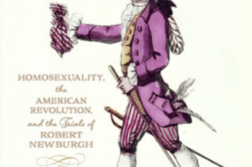NO AUTHOR writing in English has been the subject of more critical attention and speculation than Shakespeare, England’s “person of the millennium,” so dubbed by the BBC. Among the many theories and interpretations that have been applied to Shakespeare’s admittedly enigmatic and multi-layered plays and poems, relatively few have delved into the subject of homosexuality in the playwright’s life or in the theatrical world that he inhabited, while in the plays themselves this theme continues to be glossed over and rarely given the attention it deserves.
Shakespeare defied the constraints of the Elizabethan era in numerous plays, such as Hamlet, Romeo and Juliet, Troilus and Cressida, and Twelfth Night, which feature characters who violate the norms of gender or sexual behavior in their romantic relationships or their individual personae. In his cross-dressing comedies, such as Twelfth Night and As You Like It, gender rebellion and same-sex love are joyously intertwined.
Resistance to exploring these themes in Shakespeare’s life and work had, at least until recently, been a longstanding tradition throughout the history of both performance and criticism. Even today, discussion of these themes by Shakespeare scholars is often confined to GLBT circles, and even here there is resistance to the attribution of gay elements—“gay” being a strictly modern concept that has no applicability to the playwright’s times.
Shifting to popular culture, consider the film Shakespeare in Love (1998), winner of seven Oscars, including Best Picture. Directed by John Madden, the movie invents a heterosexual love affair between the young playwright and the fictitious Viola de Lesseps, played with luminous abandon by Gwyneth Paltrow. The screenplay was written by the playwright Tom Stoppard in collaboration with Marc Norman. The omission of references to homosexuality and bisexuality is surprising coming from Stoppard, author of the 1966 play Rosencrantz and Guildenstern Are Dead, a dark comedy that pulls two characters from Hamlet into the limelight and reveals a homoeroticism at the core of their symbiotic connection.
In contrast, Shakespeare in Love is relentless in removing all traces of homoerotic interest from the playwright’s life and world.
David LaFontaine, professor of English at Massasoit Community College in Canton, Massachusetts, is currently working on a book on gay themes in literature.





